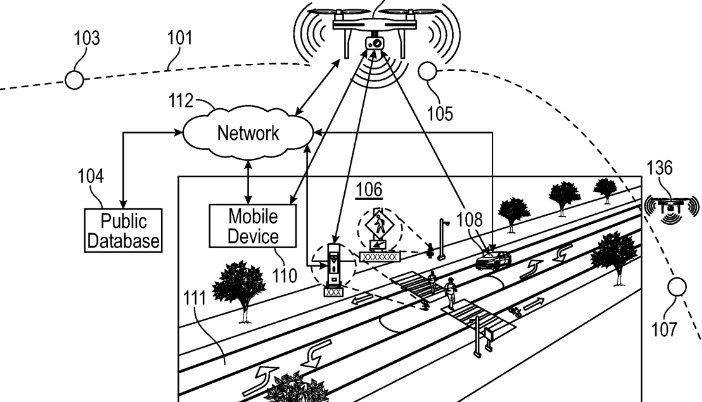While Ford is already using drones to make its factories’ inspections faster and safer, the company also seems to be targeting other industries. Over the past year, more than a dozen Ford Global Technologies’ patents regarding drone technology, deliveries, safety systems, communication and interaction with vehicles, and more were made public.
Published in late 2022, one of Ford’s latest patents focuses on systems and methods for operating drone flights over public roadways. Since the FAA and other government bodies do not allow drone flights over public roadways or near/above locations where humans are present, Ford wants to explore new ways to ensure safe drone flights. The patent envisions various scenarios where a drone uses vehicle-to-everything (V2X) technology to broadcast its current position, mobility dynamics, and planned flight path. By continuously transmitting safety messages, a drone can alert nearby vehicles or pedestrians of its presence or other drones to alter flight paths and avoid crashes. According to the National Highway Traffic Safety Administration’s (NHTSA) website, vehicle-to-vehicle (V2V) technologies can prevent 615,000 motor vehicle crashes and save 1366 lives yearly.
Following multiple published patents regarding drone integration, communication, and interaction with vehicles, Ford’s latest patent, published in January 2023, further explores safety topics when a drone operates in proximity to objects. For example, the patent describes how a drone can be configured autonomously or manually to prevent rotor activation or ensure no objects are present within a designated clearance area.
Similar to what Amazon wants to do, two other Ford patents published last year target decentralized hybrid air-ground autonomous last-mile goods deliveries and transportation using drones. Unlike Amazon’s solution, where a drone would make the delivery and return to the vehicle it left off, Ford’s patent describes delivery vehicles as drone base stations. In addition, it also considers fixed base stations spread across a location. This allows drones to conveniently switch vehicles if needed or land safely on a fixed base station if there are no available vehicles nearby. For example, a drone may leave a vehicle with a package, deliver it, and if the vehicle is gone, the drone will look for the closest nearby vehicle—if there is none, it will search for the nearest fixed base station.
Ford’s venture into the drone market dates back to 2016. At the time, DJI and Ford invited innovators to develop drone-to-vehicle communications using Ford Sync AppLink or OpenXC. The goal was to create a surveying system for the United Nations Development Program to inspect emergency zones inaccessible to even the most versatile vehicles. Using an F-150 truck as a base station, first responders could quickly deploy drones to survey and map hardest-hit areas from earthquakes or tsunamis.
Additionally, in 2018, Ford was using drones equipped with motion cameras to inspect high-rise gantries, pipework, and roof areas at its Dagenham Engine Plant in the U.K. Whereas using automated extendable platforms and scaffolding to inspect 40-meter-long gantries would take 12 hours to complete, using drones reduced it down to 12 minutes.
While all these patents do not necessarily mean that Ford has built or is close to making any of these systems, it does show the company is aware of how vital the drone industry is. Could this mean the company is working towards a drone ecosystem of some kind?




.png.small.400x400.png)











Comments